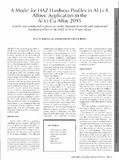A Model for HAZ Hardness Profiles in AI-Li-X Alloys: Application to the AI-Li-Cu Alloy 2095

View/
Date
1998Author
Rading, G. O
Shamsuzzoha, M
Berry, J. T
Type
ArticleLanguage
enMetadata
Show full item recordAbstract
In a previous paper (Ref. 1),
details were presented of a theoretical
model describing the evolution of the
hardness profiles in the heat-affected
zones (HAZ) of AI-Li-X weldments. The
intent of the model was to qualitatively
predict the general shape of such a profile,
which indicates points of double inflection.
In the present paper, experimental
results are presented to validate
the model. Panels of AI-Li-Cu Alloy 2095
in the peak aged (T8) condition were
welded by the gas tungsten arc (GTA)
process using AA 2319 filler metal. Conventional
transmission electron microscopy
(TEM) studies were conducted
on specimens taken from specific points
across the HAZ to estimate the relative ratios
of T1 (AI2CuLi) and _8' (AI3Li) precipitates,
as well as incoherent grain boundary
phases. Electron probe microanalysis
(EPMA) was used to determine the variation
of concentrations of elements across
the HAZ, while the hardness profile was
determined using Vickers microhardness
measurements. The hardness profile and
the associated pattern of phases present
agree well with the information predicted
qualitatively by the previously described
model.
